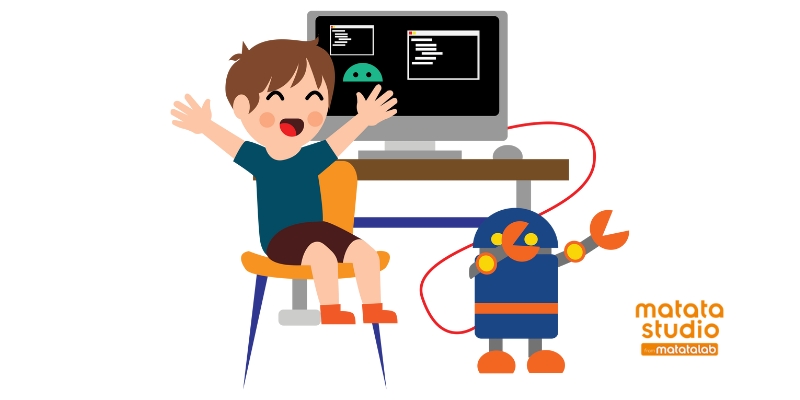Coding has become an essential skill for children, with visual coding for kids being a popular choice for young learners. Below are some frequently asked questions (FAQs) about visual coding, with detailed answers to help parents and educators make informed decisions.
Q1: What is Visual Coding?
A: Visual coding is a method of programming that uses drag-and-drop blocks or graphical interfaces to represent code. Instead of typing out commands, children snap together blocks to create programs, making it more intuitive and beginner-friendly. Platforms like Scratch, Blockly, and MatataStudio’s visual coding tools are excellent examples that integrate robotics and interactive lessons.
Q2: What Age Group is Visual Coding Suitable For?
A: Visual coding is ideal for children as young as 5 years old, depending on their interest and developmental level. It serves as a gentle introduction to programming concepts without the need for advanced reading or typing skills. Age-appropriate EdTech products designed for a wide range of learners, ensuring that children can start with basic concepts and gradually progress.
Q3: What Skills Do Children Learn Through Visual Coding?
A: It helps children understand key programming concepts such as sequencing, loops, conditionals, and events. It also enhances problem-solving, logical thinking, and creativity. Additionally, children can develop skills in algorithmic thinking and debugging, learning how to identify and fix issues in their code. These technical skills lay the groundwork for more complex programming challenges in the future.
Q4: Is Visual Coding a Substitute for Textual Coding?
A: No, it is not a replacement for textual coding. Instead, it acts as a stepping stone. Visual coding builds foundational knowledge that children can build upon when transitioning to textual coding languages like Python or JavaScript.
Q5: What Are the Benefits of Visual Coding?
A: The benefits of visual coding are as follows:
- Engaging Interface: The colorful and interactive design makes coding enjoyable.
- Low Entry Barrier: No prior experience is needed.
- Immediate Feedback: Kids can see results instantly, boosting confidence.
- Encourages Experimentation: The risk-free environment allows children to explore and learn from mistakes.
Q6: What Are the Limitations of Visual Coding?
A: While visual coding for kids is excellent for beginners, it may oversimplify programming and is less suited for advanced or professional projects. Transitioning to textual coding is essential for more complex tasks.
Q7: How Does Visual Coding Compare to Textual Coding?
A: Visual coding for kids focuses on ease of use and engagement, making it perfect for beginners. Textual coding, however, involves writing commands in programming languages, offering more power and flexibility for complex projects. A blended approach works best, starting with visual coding and gradually introducing textual coding.
Q8: How Can Parents and Teachers Support Visual Coding?
A: Parents and teachers can support their child’s visual coding journey by following the below tips:
- Encourage children to explore platforms like Scratch, Code.org, and MatataStudio.
- Provide resources like tutorials and guides.
- Celebrate successes and guide them through challenges.
- Gradually introduce textual coding to expand their skills.
Q9: What is MatataStudio, and How Does It Relate to Visual Coding?
A: MatataStudio is an innovative coding platform designed for young learners. It integrates visual learning with robotics, allowing children to program robots using block-based coding. MatataStudio emphasizes hands-on learning, creativity, and problem-solving, making it an ideal tool for children to explore the world of coding in a fun and interactive way. MatataStudio’s various products offer interactive learning experiences where kids can apply coding concepts to real-world objects, such as robots, making the learning process engaging and practical.
Q10: What Makes MatataStudio Unique?
A: The following features make MatataStudio unique:
- Integration with Robotics: Children can see their code come to life by programming robots with MatataStudio’s visual coding tools.
- Interactive Lessons: Engaging and age-appropriate lessons ensure sustained interest.
- Seamless Transition: MatataStudio prepares children for textual coding by introducing fundamental concepts in a visual format, making the transition to more advanced coding smoother.
- Hands-on Learning: Products like the MatataStudio Game Box for Coding Set Series offer tangible experiences that combine coding with play.
Q11: How Can Educators Use MatataStudio in the Classroom?
A: Educators can use MatataStudio to teach visual coding for kids, robotics, and STEAM concepts. The platform offers structured lesson plans and activities aligned with educational standards, making it easy to integrate into curricula. Whether using the MatataStudio Creator Kit or the Game Box for Coding Set, educators can engage students in both theoretical and practical coding exercises.
Visual coding for kids, including platforms like MatataStudio, offers an engaging and accessible entry point into the world of programming for children. By addressing common questions and understanding the benefits of visual coding, parents and educators can guide children on a learning journey that inspires creativity and builds critical skills for the future. Whether starting with block-based platforms like MatataStudio or progressing to textual coding, the ultimate goal is to nurture a love for technology and problem-solving in young minds.

